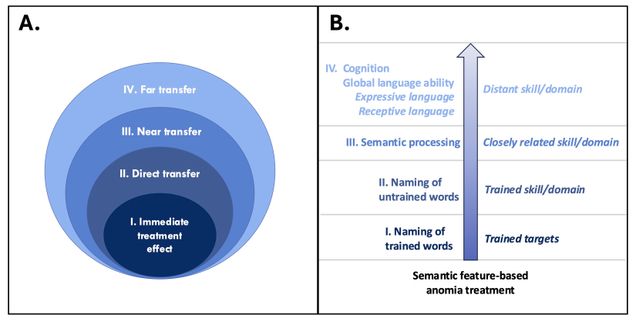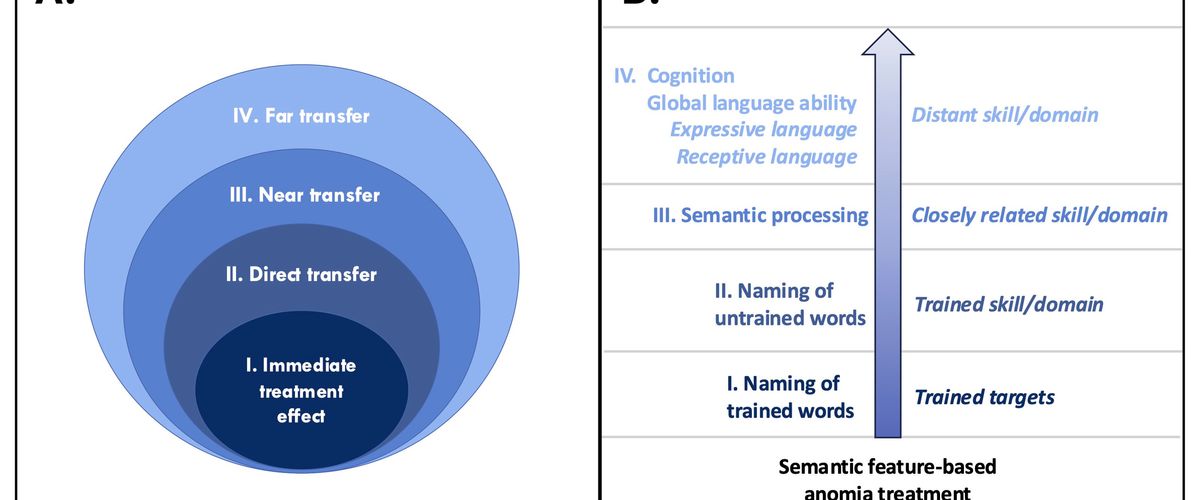Russell-Meill, M., Carpenter, E., Marte, M. J., Scimeca, M., Peñaloza, C., & Kiran, S. (2025). Measurement of cross-language and cross-domain generalization following semantic feature-based anomia treatment in bilingual aphasia. Neuropsychological Rehabilitation, 1–27. https://doi.org/10.1080/09602011.2025.2522196
Abstract
Semantic feature-based treatment (SFT), which engages the semantic network by repeatedly targeting retrieval of conceptual features to improve lexical-semantic access, has shown promise for facilitating generalization in aphasia rehabilitation. However, its capacity to drive broad improvement across cognitive-linguistic domains in bilinguals with aphasia (BWA) remains unclear. This study examined generalization effects (i.e., direct transfer, near transfer, and far transfer) following SFT in 48 Spanish-English BWA who took part in a randomized controlled trial. Participants received 40 h of SFT targeting word retrieval, with generalization assessed across three domains: naming of untrained items (direct transfer), semantic processing (near transfer), as well as global language ability and nonverbal abstract reasoning (far transfer). Results showed (i) robust improvements for trained and untrained naming targets, demonstrating direct transfer, (ii) near transfer effects for select semantic processing tasks, and (iii) far transfer limited to overall language function, with no gains in domain-general cognition. Notably, treatment benefits extended across languages, demonstrating cross-language generalization to multiple domains of language processing. Findings highlight SFT’s capacity to drive comprehensive language recovery in BWA, revealing broad generalization effects across languages and linguistic domains. Such effects underscore the importance of systematically examining generalization patterns to optimize rehabilitation outcomes.

Q&A with Marissa Russell-Meill
What is this paper about?
We examined whether gains following semantic feature-based treatment (SFT)—a therapy that targets word retrieval by activating conceptual features—led to improvements beyond trained targets. Forty-eight Spanish-English bilinguals with aphasia received 40 hours of therapy in one language (English or Spanish), and we assessed whether treatment effects extended to untrained words (direct transfer), related semantic tasks (near transfer), and broader language and cognitive abilities (far transfer). We also examined whether these gains appeared in the untreated language, capturing cross-language transfer at each level. Results showed evidence of generalization across all three levels in the treated language, with gains largely extending to the untreated language. However, transfer was limited to language abilities—there were no improvements in nonlinguistic cognitive measures, and gains on more cognitively demanding semantic tasks were also limited.
How do the findings relate to the brain and recovery?
Our findings demonstrate that therapy in one language can lead to meaningful improvements in both languages, supporting recovery across a range of language skills. However, the extent of generalization varied systematically: gains were strongest for tasks closely aligned with the treatment and less consistent for tasks that required greater semantic control. While improvements were observed in overall language ability, no changes were seen in nonlinguistic cognitive performance. This pattern suggests that treatment engaged language-specific processes, and that generalization was shaped by both the similarity of the outcome task to the treatment focus and the cognitive demands involved.
